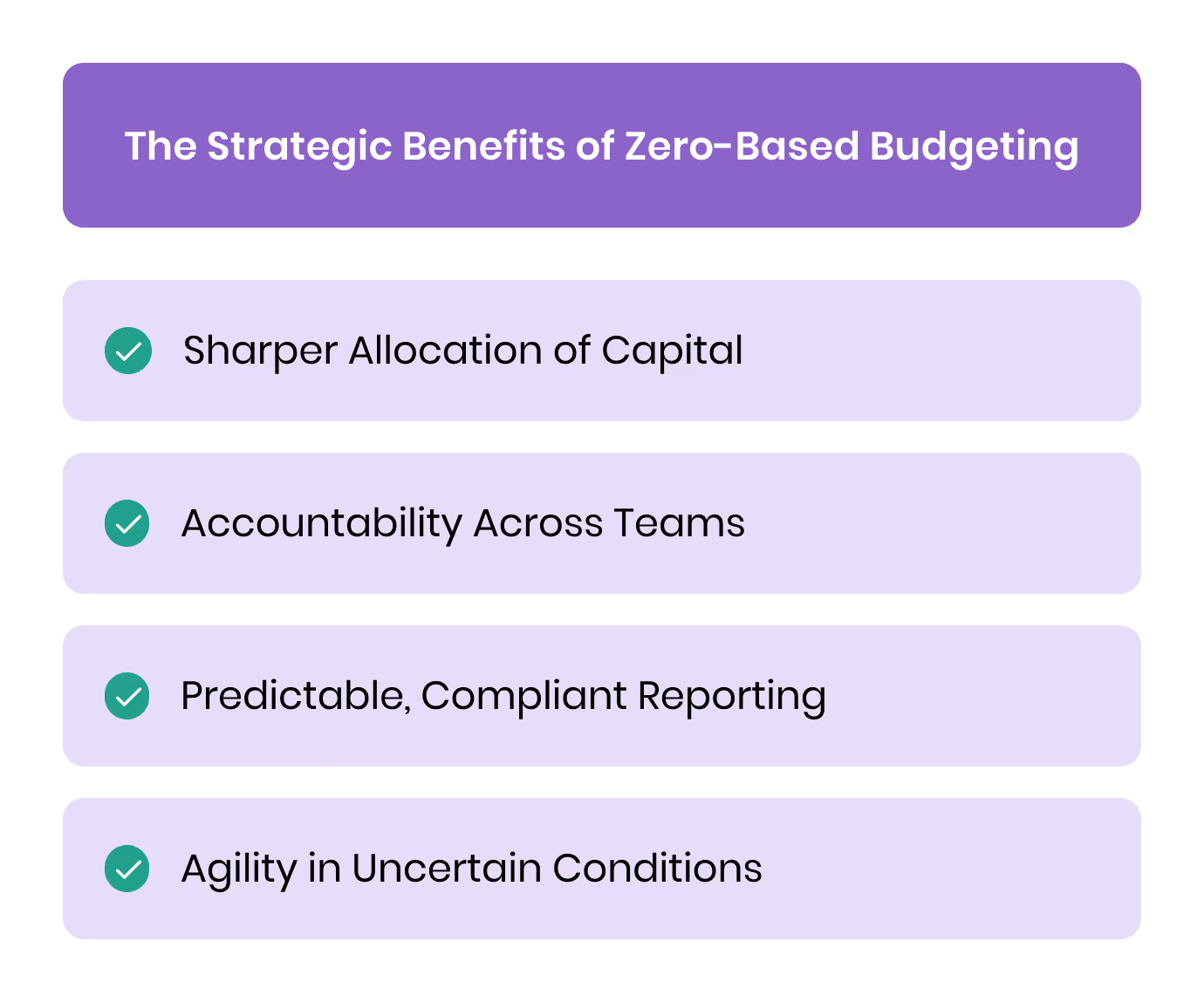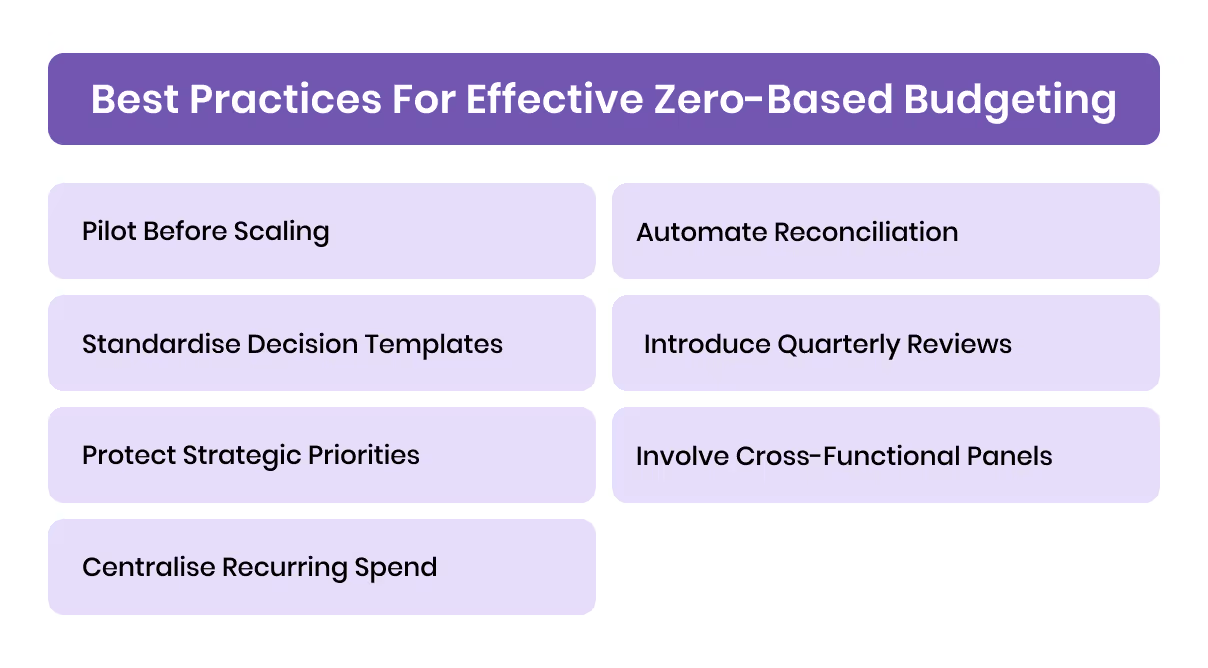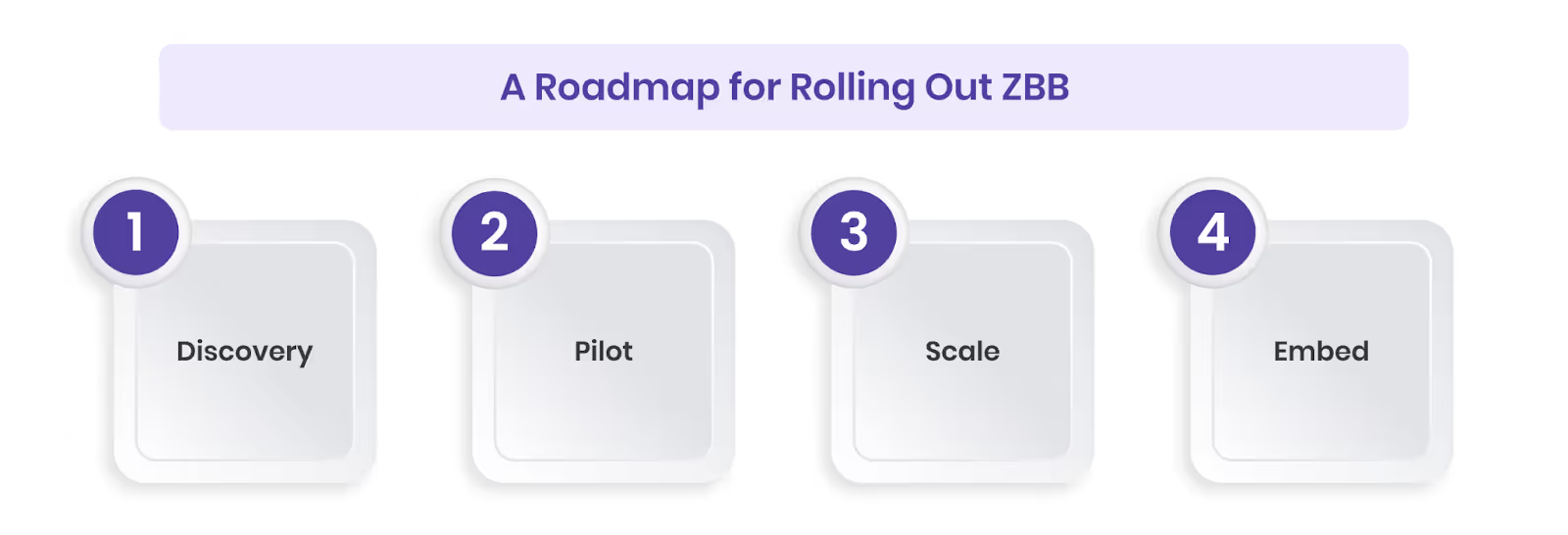Budgets often grow heavier with time. Legacy contracts get renewed automatically, SaaS tools remain active long after teams stop using them, and recurring vendor payments slip by without scrutiny. What starts as convenience can quietly become a financial drag, limiting flexibility, reducing profitability, and exposing compliance gaps.
Zero-based budgeting (ZBB) offers a reset. Instead of assuming last year's spend is the baseline, every expense must be justified from scratch in each cycle. This shifts the question from "What did we spend last year?" to "Does this cost still create value today?"
It's a discipline that unlocks sharper allocation of resources, tighter control of recurring costs, and a clearer link between strategy and spend.
To understand why zero-based budgeting matters, it is helpful to first examine the limitations of traditional budgeting.
Key Takeaways
- What is Zero-Based Budgeting: ZBB requires justifying every expense from scratch, shifting focus from historical spend to current value.
- How ZBB Works: Departments submit decision packages outlining need, outcomes, alternatives, and resources; leadership funds based on alignment with strategy.
- Strategic Benefits: It improves capital allocation, accountability, compliance, and agility in uncertain conditions.
- Best Practices: Pilot ZBB, standardize templates, protect strategic priorities, centralise spend, automate reconciliation, conduct quarterly reviews, and involve cross-functional panels.
- Implementation Roadmap: Discover, pilot, scale, and embed zero-based budgeting gradually to avoid disruption and build confidence.
Why Traditional Budgeting Falls Short
Most budgets are built incrementally: last year’s figures plus or minus a percentage. On the surface, this seems efficient. In reality, it creates problems:
- Budget creep: Costs grow each year without real scrutiny.
- Legacy commitments: Vendor contracts and subscriptions remain untouched, even if they’re underutilised.
- Poor visibility: Recurring charges across departments are hard to track, making forecasting unreliable.
- Compliance risks: In regions with VAT, invoices and records often get overlooked when spend is scattered.
This incremental method rewards inertia rather than performance. Budgets roll forward unchecked, while strategic priorities struggle to gain room.
Case Study: Kraft Heinz and the Cost of Budget Inertia
For years, Kraft and Heinz followed the same routine, rolling last year's numbers forward with minor adjustments. It felt efficient, but over time, it accumulated waste: overlapping vendor contracts, unused perks, and inflated overhead that no one really questioned.
Following their 2015 merger, new management implemented zero-based budgeting, effectively resetting the budget. Within about 15 months, overhead dropped from roughly 18% to 11%, a significant win on paper. But the cuts went deep, and critics later argued that the aggressive savings came at the expense of innovation and long-term growth.
The takeaway? Incremental budgeting allowed inefficiencies to fester until a drastic correction became unavoidable. While zero-based budgeting brought short-term gains, its extreme implementation highlighted the need for balance , a balance between scrutiny and suffocation. The real lesson is that budgets must be continually challenged, not ignored until they necessitate a painful overhaul.
What Zero-Based Budgeting Means for your Business
ZBB starts from zero. Every cost must be justified based on its current value to the business, not its historical presence.
Departments or cost centres build decision packages that explain:
- Why the expense is needed.
- What outcomes it supports.
- Alternatives or efficiencies available.
- The exact resources required.
Leadership then prioritises these packages, funding those that align with strategic priorities and reshaping or eliminating those that don't. This approach creates a culture of accountability where budgets are earned, not inherited — ensuring that every dirham spent delivers measurable value.
For example, consider a Marketing Automation Platform Renewal, a recurring expense that often continues unchecked. Under a ZBB approach, the marketing team would present a structured decision package:
Department: Marketing
Proposed Spend: AED 220,000 annually
Purpose: Renewal of the marketing automation platform to support lead nurturing, segmentation, and campaign performance tracking.
Justification: The tool enhances the conversion rate between Marketing Qualified Leads (MQLs) and Sales Qualified Leads (SQLs), providing visibility into marketing ROI. Without it, the team would revert to manual tracking, resulting in reduced efficiency and data accuracy.
Outcomes Supported:
- Improve MQL-to-SQL conversion from 42% to 55%
- Reduce manual campaign execution time by 20%
- Strengthen forecasting accuracy for finance and sales planning
Alternatives Considered:
- Downgrade from enterprise to mid-tier plan, saving approximately AED 55,000 annually while maintaining 90% of functionality.
- Consolidate reporting with the existing CRM to eliminate redundant tools and streamline operations.
Resources Required:
- AED 165,000 for the mid-tier subscription
- AED 55,000 for onboarding and training
- Total: AED 220,000
This example demonstrates how ZBB transforms spend justification from a formality into a strategic dialogue. Each expense becomes an active decision tied to outcomes and efficiency, aligning finance and operations around measurable business value.
How to Know Zero-Based Budgeting Is Working for You
Zero-based budgeting isn't just about cost control—it's about creating a more innovative, more intentional way to spend. When it's working, you'll feel the shift across your finance operations and team culture.
You'll know ZBB is delivering when:
- Percentage of costs eliminated or reprioritized — spending naturally aligns to strategy; every budget line earns its place.
- Budget cycle time reduced — planning feels lighter and faster, with fewer manual reconciliations and last-minute surprises.
- Forecasting accuracy improved — your team starts predicting with confidence, not explaining variances after the fact.
- VAT reclaim rate increased — cleaner, automated expense data turns compliance into cash flow.
- Share of savings reinvested into growth initiatives — efficiency gains are visible in new hires, innovation, and expansion, proof that ZBB fuels growth, not just cuts.
When these indicators start to show up, zero-based budgeting becomes more than a financial process, it becomes part of how the business thinks: disciplined, data-driven, and growth-minded.
The Strategic Benefits of Zero-Based Budgeting

Zero-based budgeting is often framed as an exercise in cost-cutting. But for finance leaders, its true value lies in reallocating resources toward growth while maintaining financial discipline. Done right, it reshapes how capital is deployed, how teams think about spend, and how leaders steer the company through uncertainty.
1. Sharper Allocation of Capital
Instead of carrying forward historic budgets year after year, ZBB forces each cost line to be re-justified. This means funds are actively redirected away from low-value legacy costs. For example, underutilised SaaS licences, vendor retainers that add little impact, or travel patterns that no longer serve business goals.
The benefit is that more capital can be channelled into strategic bets, new markets, product innovation, or digital transformation. This gives a clearer link between money spent and business outcomes achieved.
2. Accountability Across Teams
With zero-based budgeting, every budget owner must defend their line items. This creates cultural accountability, where costs are tied to measurable outputs.
This transparency makes it easier to benchmark spend across departments and spot inefficiencies early. It also strengthens collaboration, as managers become partners in cost discipline instead of passive recipients of budget allocations.
3. Predictable, Compliant Reporting
Recurring vendor charges, licences, marketing retainers, and travel bookings often slip through unnoticed in traditional budgeting. ZBB reviews them systematically, surfacing inefficiencies while ensuring each invoice meets compliance requirements (for example, VAT-compliant invoicing in the UAE/KSA).
This improves audit readiness and avoids the painful scenario of lost VAT claims or audit red flags, a risk that grows with decentralised spend.
4. Agility in Uncertain Conditions
Markets in the GCC are dynamic, from regulatory shifts to oil price volatility to rapid expansion opportunities. Zero-based budgeting equips finance leaders to realign budgets quickly without being tied to outdated allocations.
When implemented with digital spend controls (e.g., corporate cards and centralised dashboards), budget adjustments become faster and less disruptive, providing agility in volatile conditions.
[cta-4]
Organisations that route recurring spend through a single corporate card and expense platform find ZBB far easier to implement. With Alaan, finance teams can gain that real-time visibility and control, making zero-based budgeting practical rather than burdensome.
While the benefits are impactful, you need to be aware of some common mistakes.
Suggested read: Difference between Budgeting and Financial Forecasting
Where Zero-Based Budgeting Goes Wrong (and How Modern Finance Teams Fix It)
ZBB is powerful, but without the right design, it risks becoming a bureaucratic burden rather than a driver of efficiency. Following are the of the most common traps to be aware of:
- Excessive Administrative Load: If every receipt and invoice requires manual review, ZBB becomes resource-draining.
- Short-Termism: Teams may cut long-term investments, like employee training or R&D, simply because they don’t yield immediate ROI.
- Resistance From Managers: If zero-based budgeting feels like “budget policing,” managers disengage and treat it as a compliance exercise rather than a growth enabler.
These pitfalls almost always arise when data is fragmented and processes rely too heavily on manual spreadsheets.
But when finance teams combine zero-based budgeting with automated controls and real-time visibility, it shifts from a one-off cost-cutting exercise to a sustainable framework for smarter, more strategic spending.
Alaan makes this transformation possible, bringing together corporate cards, AI-driven expense management, and automated budgeting in one system built for modern finance teams.
[cta-6]
Best Practices for Effective Zero-based Budgeting

For zero-based budgeting to deliver lasting results, it needs to balance rigour with practicality. The following practices help finance leaders embed it successfully without overwhelming teams:
1. Pilot Before Scaling
Rolling out ZBB across the company on day one can feel overwhelming. Instead, pilot it in a spend-heavy category like SaaS or business travel, areas where overspend is common and results are visible quickly. Success here builds credibility and momentum for wider adoption.
2. Standardise Decision Templates
Avoid drowning teams in paperwork. Create short, standardised templates for justifying spend, focused on ROI, strategic alignment, and compliance. This makes reviews consistent while cutting down time wasted on over-documentation.
3. Protect Strategic Priorities
ZBB shouldn’t undermine future growth. Ringfence budgets for critical initiatives such as digital transformation, market expansion, or employee development. This ensures cost discipline doesn’t come at the expense of long-term competitiveness.
4. Centralise Recurring Spend
Recurring vendor payments (cloud, retainers) are where waste hides. Routing them through a single controlled system ensures visibility, prevents duplication, and strengthens vendor negotiations.
5. Automate Reconciliation
Manual matching of receipts to transactions erodes efficiency. Automation eliminates this burden, ensuring transactions are coded, categorised, and compliance-checked without last-minute fire drills.
6. Introduce Quarterly Reviews
Annual reviews are too slow for categories like SaaS, where usage and pricing change frequently. Quarterly ZBB reviews for dynamic spend categories keep budgets agile and aligned with real needs.
7. Involve Cross-Functional Panels
Bring procurement, finance, and operations together in budget reviews. This ensures decisions strike the right balance between control and operational practicality — avoiding “finance-only” decisions that may frustrate business teams.
With Alaan, finance teams often cut reconciliation time significantly by combining card payments, receipt capture, and VAT validation into one flow. This makes quarterly ZBB reviews practical, not painful.
To bring all of this together, a phased rollout ensures ZBB doesn’t disrupt day-to-day operations.
Suggested read: Best Expense Tracking Software for Small Business of 2025
A Roadmap for Rolling Out ZBB

ZBB can’t be dropped into an organisation overnight. A phased rollout ensures discipline builds without disrupting day-to-day operations.
Phase 1: Discovery
Conduct a comprehensive audit of current spend. Capture every recurring vendor charge, SaaS licence, and departmental expense to establish a reliable baseline. Without this clarity, ZBB decisions risk being based on incomplete data.
Phase 2: Pilot
Apply ZBB to one high-impact category such as travel or software subscriptions. Refine decision templates and review workflows in this smaller environment before scaling. This allows teams to test the process, demonstrate savings, and build buy-in.
Phase 3: Scale
Expand ZBB across departments, supported by automated spend capture. Centralising recurring spend through corporate cards and dashboards ensures consistency and keeps processes manageable.
Phase 4: Embed
Make it part of the financial rhythm, integrated into quarterly reviews or annual cycles. Feed the insights into forecasting and strategic planning, so ZBB isn’t a one-off project but a continuous discipline.
Ultimately, the value of ZBB lies in building a culture of questioning costs and linking spend to impact.
Conclusion
Zero-based budgeting isn’t just about trimming expenses. It’s about ensuring every cost serves a clear purpose today, not just yesterday. Done well, it sharpens decision-making, frees resources for growth, and strengthens compliance.
The challenge has always been execution. Manual ZBB is heavy. Automated ZBB is sustainable.
At Alaan, we make this possible. By centralising spend through corporate cards, automating reconciliation, and ensuring VAT compliance from day one, finance teams gain the clarity to apply ZBB without the manual burden.
Schedule a demo to see how Alaan can help your business turn zero-based budgeting from theory into practice, with less effort and greater control.
FAQs
1. How does zero-based budgeting differ from traditional budgeting?
Traditional budgeting rolls forward last year’s numbers with minor adjustments. ZBB starts from zero, requiring justification for every line item.
2. Is ZBB just about cutting costs?
No. The goal is smarter allocation. Savings from low-value costs can be reinvested in growth and innovation.
3. How can companies avoid ZBB becoming too heavy?
Automating data capture and reconciliation reduces manual effort, keeping the focus on decisions rather than admin.
4. Which areas are best for ZBB pilots?
High-volume, recurring spend categories such as SaaS, marketing, or business travel procurement.
5. Can ZBB improve compliance in the UAE and KSA?
Yes. By linking each expense to valid invoices and VAT records, ZBB strengthens audit readiness and reduces risk.


.avif)






%201.avif)